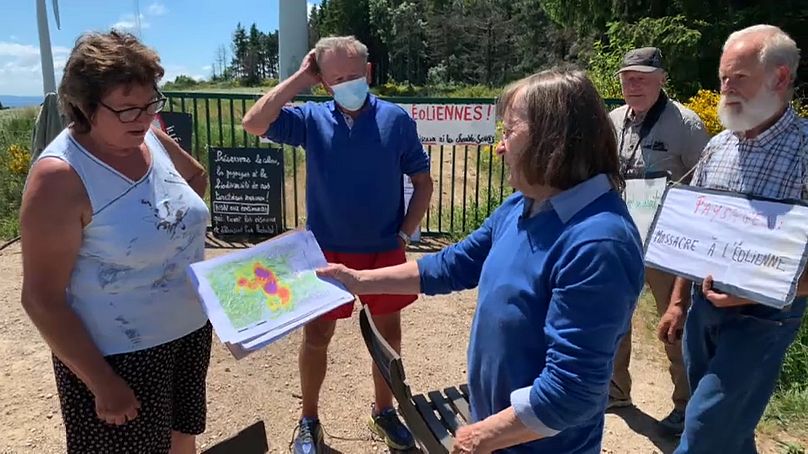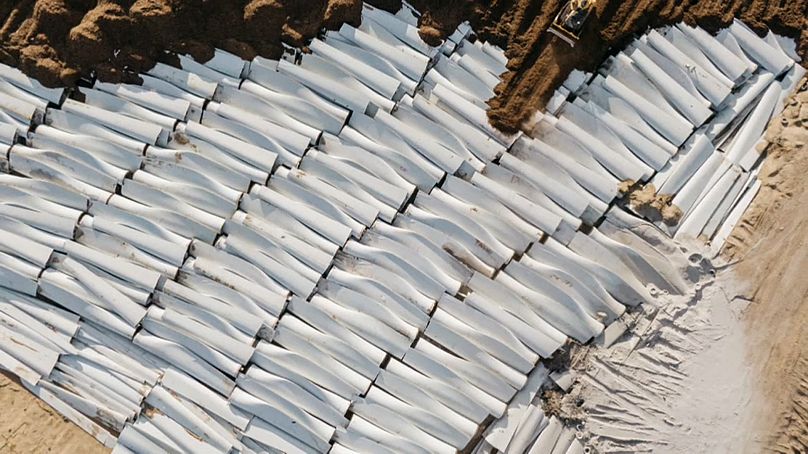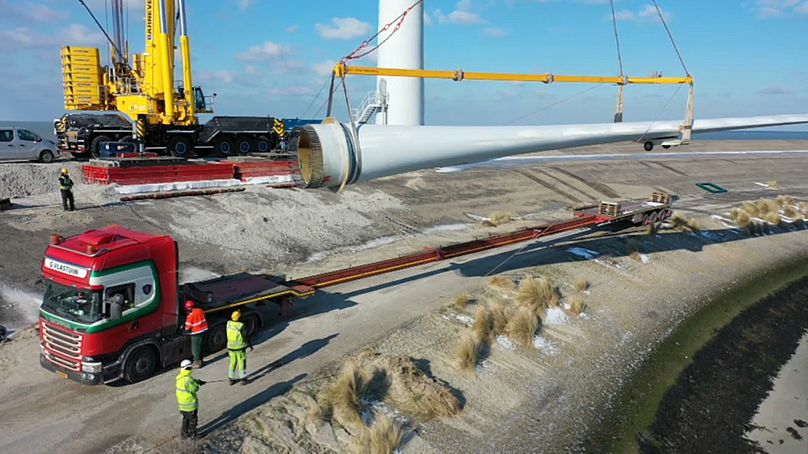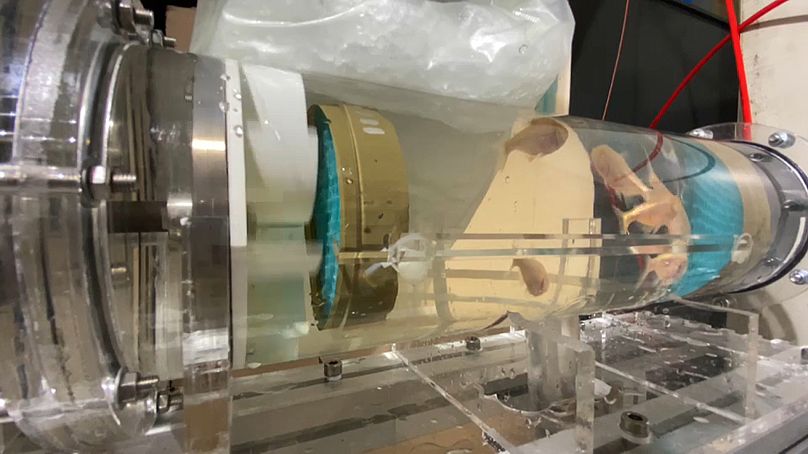In this episode of Unreported Europe, Monica Pinna investigates the latest controversy engulfing the wind power sector - - the recycling of turbine blades. We’re looking at how the market and researchers are pushing for higher sustainability. That's coming up on Unreported Europe
In this episode of Unreported Europe, Monica Pinna investigates the latest controversy engulfing the wind power sector - the recycling of turbine blades.
For some, wind turbines are extraordinary pieces of technology and the answer to our energy needs. For others they are a blot on the landscape and a threat to biodiversity.
One thing is for sure. A storm is brewing over the future of wind power in Europe. The latest controversy concerns the difficulty to recycle turbine blades.
Local opposition
Residents in and around the town of Lunas, in Southern France, want seven turbines in the Bernagues wind farm dismantled. They see them as an eyesore and a threat to the natural environment. Their residents group, Collectif 34-12, has been tied up in a legal battle for several years in a bid to get the turbines pulled down. The court case is still ongoing.
"We’re not against wind power. We’re opposed to putting turbines in areas which are rich in terms of biodiversity. In Occitania, this is the case for roughly 70% of the region," says Marion Valé, the group's spokesperson.
At the start of June, Marion called on residents to rally outside the Bernagues wind farm after the site’s developer won a court appeal preventing the disputed wind turbines from being dismantled.
“The Bernagues wind turbines are a symbol, a symbol of all the turbines that should be destroyed or dismantled on all the mountain ridges in France,” Marion argues.
Out with the old, in with the new
A huge number of wind turbines will soon be dismantled across Europe. But only a small number of these will go because of local opposition from residents. The majority are up for renewal and need replacing as they are part of the first generation of wind turbines that were built in the 1990s.
The process, called repowering, has begun all over Europe. Élisabeth Calenza, a project manager from Engie Belgium, says the new turbines will be far more productive.
“It will double output. We will go from 2 to 4.2 Megawatts per turbine. This means we will triple the electricity produced. We will surpass 9,000 Kilowatts per hour. This will supply almost 5,800 families.”
Repowering means some 5,700 wind turbines per year could be decommissioned in Europe by 2030.
While up to 90 percent of a wind turbine can now be recycled, the problem remains the blades. These are made from composite materials that were intended to last and are not easily recyclable.
What happens to the old blades?
Most old blades are reused. However, it’s forecast the number of decommissioned blades will be so high in five to ten years that the current management system will need to change.
“At this moment about 80 percent of all the wind turbines we dismantle are being used as a wind turbines somewhere else. That's either Europe - Italy, UK, Sweden, Denmark. But the other 20 percent is being recycled. That's because it's not economically feasible to use them again. But in the very near future, I think two years from now, about 80 percent will have to be recycled because there's less space for used turbines and bigger new turbines are much more competitive,” explained Wim Robbertesen, the Managing Director of Business in Wind. His company specialises in giving a circular life-cycle to wind turbines.
In Europe, most blades that are not reused or incinerated, end up in landfill. This image above of a blade graveyard in the US has become symbolic of the darker side of this renewable energy.
“We do not want these blades to end up in landfill."
Only four countries in Europe - Germany, Austria, The Netherlands and Finland - have banned blades being sent to landfill. The leading voice of Europe’s wind energy industry has called for a Europe-wide landfill ban by 2025.
“We do not want these blades to end up in landfill. The blades are admittedly non-toxic and technically, they are landfill safe, but it is a waste of valuable resources and it is incompatible with the wind industry's commitment to full circularity that we should be putting blade waste in landfill,” said Giles Dickson, CEO, Wind Europe.
Right now only a handful of facilities in Europe can recycle blades. The technology remains relatively new and drastically needs to be scaled up. One Spanish startup, Reciclalia, takes blades from France, Portugal and North Africa. By the end of 2021 they say they will be able to recycle 1,500 blades a year.
“We are able to eliminate all the organic matter that is present in these composite materials, so that in the end we obtain the glass fibre and, more importantly, the carbon fibre, which is clean, so it can be used again. We are working with pioneering companies in sectors as diverse as ceramics, construction, and transport - including the automotive and aeronautic sectors," said David Romero, Reciclalia's Chief Operating Officer.
The quest for a fully recyclable blade
Representatives from the wind energy industry believe calls for a EU-wide landfill ban will accelerate the scaling up of recycling technology. That in turn will see demand for recycled materials rise.
Danish wind power giant Vestas insists it is doing a lot to improve sustainability across the entire value chain, from design to manufacture. The ultimate goal is to produce a 100 percent recyclable blade.
“Our blades are today roughly recyclable at a rate of 42 percent, 42, 43 percent. So there's still a way to go. But if you're asking when we will reach that 100 percent, I think that will still take a while,” says Lisa Ekstrand, Head of Sustainability at Vestas.
Rethinking the amount of energy we need
The industry is striving to improve production, efficiency and circularity. But should we be asking how much energy we need in the first place? It's a broader question that the Paris Interdisciplinary Energy Research Institute (LIED) is attempting to answer.
“We always imagine energy should be produced at maximum output, at the best possible efficiency, or inversely, as powerfully as possible. In fact, this is not what nature does. For example, when we move, it's natural to minimise the production of waste. An animal, when it moves, wants to be the least tired as possible at the end of the day. So the key characteristic of an energy production system should be geared towards lowering consumption by trying to manage consumption differently. In other words, we should try to manage the way we function as a society differently,” explains Assistant Professor Eric Herbert.
Perhaps this example from the natural world is the best guide to finding the right balance between protecting the environment and meeting our energy needs.














